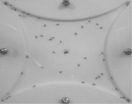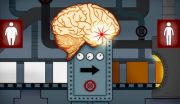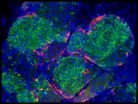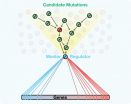(Press-News.org) VIDEO:
Behavior experiments in which flies were given the choice between wild-type and mutant fermentation headspace in the middle of the experiment, and they migrate accordingly.
Click here for more information.
The familiar smell of beer is due in part to aroma compounds produced by common brewer's yeast. Now, researchers reporting in the Cell Press journal Cell Reports on October 9th have discovered why the yeast (formally known as S. cerevisiae) make that smell: the scent attracts fruit flies, which repay the yeast by dispersing their cells in the environment.
Yeast lacking a single aroma gene fail to produce their characteristic odor, and they don't attract fruit flies either.
"Two seemingly unrelated species, yeasts and flies, have developed an intricate symbiosis based on smell," said Kevin Verstrepen of KU Leuven and VIB in Belgium. "The flies can feed on the yeasts, and the yeasts benefit from the movement of the flies."
Verstrepen first got an idea that this might be going on about 15 years ago as a graduate student studying how yeast cells contribute to the flavor of beer and wine. He discovered that yeast cells produce several pleasing aroma compounds similar to those produced by ripening fruits. It turns out that one yeast gene in particular, called ATF1 for alcohol acetyl transferase, was responsible for the lion's share of those volatile chemicals.
VIDEO:
This is footage of a fly eating from a yeast colony and clearly disturbing it in the mean time.
Click here for more information.
An accidental escape hinted at what those scents might be good for: "When returning to the lab after a weekend, I found that a flask with a smelly yeast culture was infested by fruit flies that had escaped from a neighboring genetics lab, whereas another flask that contained a mutant yeast strain in which the aroma gene was deleted did not contain any flies," Verstrepen recalls.
But it wasn't until years later, when he teamed up with fruit fly neurobiologists Emre Yaksi and Bassem Hassan, that the story finally came together.
Using a combination of molecular biology, neurobiology and behavioral tests, the researchers now show that loss of ATF1 changes the response of the fruit fly brain to a whiff of yeast. As a result, the flies are much less attracted to the mutant yeast cells, which in turn results in reduced dispersal of mutant yeast by the flies.
Together, the results uncover an intriguing aroma-based communication and mutualism between microbes and insects, the researchers say. They suspect that similar mechanisms may exist in other plant-associated microbes, including pathogens.
In fact, the research team has isolated many different yeast species from the bodies of fruit flies in nature to find that the vast majority of those yeasts produce aroma compounds. They have also isolated several strong aroma-producing yeasts from flowers.
"These preliminary results suggest that aroma production is not restricted to S. cerevisiae and may be a much more general theme in microbe-insect interactions," the researchers write.
INFORMATION:
Cell Reports, Christiaens et al.: "The fungal aroma gene ATF1 promotes dispersal of yeast cells through insect vectors."
Oxytocin has been called the "love hormone" because it plays an important role in social behaviors, such as maternal care and pair bonding. In a study published by Cell Press on October 9th in the journal Cell, researchers uncover oxytocin-responsive brain cells that are necessary for female social interest in male mice during estrus—the sexually receptive phase of their cycle. These neurons, found in the prefrontal cortex, may play a role in other oxytocin-related social behaviors such as intimacy, love, or mother-child bonding.
"Our findings suggest that social ...
Oxytocin, the body's natural love potion, helps couples fall in love, makes mothers bond with their babies, and encourages teams to work together. Now new research at Rockefeller University reveals a mechanism by which this prosocial hormone has its effect on interactions between the sexes, at least in certain situations. The key, it turns out, is a newly discovered class of brain cells.
"By identifying a new population of neurons activated by oxytocin, we have uncovered one way this chemical signal influences interactions between male and female mice," says Nathaniel ...
Researchers at Yale School of Medicine have uncovered a molecular process in the brain known to control eating that transforms white fat into brown fat. This process impacts how much energy we burn and how much weight we can lose. The results are published in the Oct. 9 issue of the journal Cell.
Obesity is a rising global epidemic. Excess fatty tissue is a major risk factor for type 2 diabetes, cardiovascular disease, hypertension, neurological disorders, and cancer. People become overweight and obese when energy intake exceeds energy expenditure, and excess calories ...
Harvard stem cell researchers today announced that they have made a giant leap forward in the quest to find a truly effective treatment for type 1 diabetes, a condition that affects an estimated three million Americans at a cost of about $15 billion annually:
With human embryonic stem cells as a starting point, the scientists are for the first time able to produce, in the kind of massive quantities needed for cell transplantation and pharmaceutical purposes, human insulin-producing beta cells equivalent in most every way to normally functioning beta cells.
Doug Melton, ...
CAMBRIDGE, Mass. (October 9, 2014) – Within almost every human cell is a nucleus six microns in diameter—about one 300th of a human hair's width—that is filled with roughly three meters of DNA. As the instructions for all cell processes, the DNA must be accessible to the cell's transcription machinery yet be compressed tightly enough to fit inside the nucleus. Scientists have long theorized that the way DNA is packaged affects gene expression. Whitehead Institute researchers present the first evidence that DNA scaffolding is responsible for enhancing and ...
BOSTON – The surprising discovery of a previously unidentified class of lipid molecules that enhance insulin sensitivity and blood sugar control offers a promising new avenue for the prevention and treatment of type 2 diabetes.
The new findings, made by a team of scientists from Beth Israel Deaconess Medical Center (BIDMC) and the Salk Institute, are described in the October 9 online issue of the journal Cell.
"We were blown away to discover this completely new class of molecules," says senior author Barbara Kahn, MD, Vice Chair of the Department of Medicine ...
Beer yeasts produce chemicals that mimic the aroma of fruits in order to attract flies that can transport the yeast cells to new niches, report scientists from VIB, KU Leuven and NERF in the reputed journal Cell Reports. Interestingly, these volatile compounds are also essential for the flavor of beverages such as beer and wine.
Kevin Verstrepen (VIB/KU Leuven): "The importance of yeast in beer brewing has long been underestimated. But recent research shows that the choice of a particular yeast strain or variety explains differences in taste between different beers and ...
A key mechanism behind diabetes may start in the brain, with early signs of the disease detectable through rising levels of molecules not previously linked to insulin signaling, according to a study led by researchers at the Icahn School of Medicine at Mount Sinai published today in the journal Cell Metabolism.
Past studies had found that levels of a key set of protein building blocks, branched-chain amino acids (BCAAs), are higher in obese and diabetic patient, and that this rise occurs many years before someone develops diabetes. Why and how BCAA breakdown may be ...
NEW YORK, NY (October 9, 2014)—Using an innovative algorithm that analyzes gene regulatory and signaling networks, Columbia University Medical Center (CUMC) researchers have found that loss of a gene called KLHL9 is the driving force behind the most aggressive form of glioblastoma, the most common form of brain cancer. The CUMC team demonstrated in mice transplants that these tumors can be suppressed by reintroducing KLHL9 protein, offering a possible strategy for treating this lethal disease. The study was published today in the online issue of Cell.
The team used ...
VIDEO:
Salk researchers explain how a new class of lipids may be tied to diabetes.
Click here for more information.
LA JOLLA—Scientists at the Salk Institute and Beth Israel Deaconess Medical Center (BIDMC) in Boston have discovered a new class of molecules—produced in human and mouse fat—that protects against diabetes.
The researchers found that giving this new fat, or lipid, to mice with the equivalent of type 2 diabetes lowered their elevated blood sugar, ...







